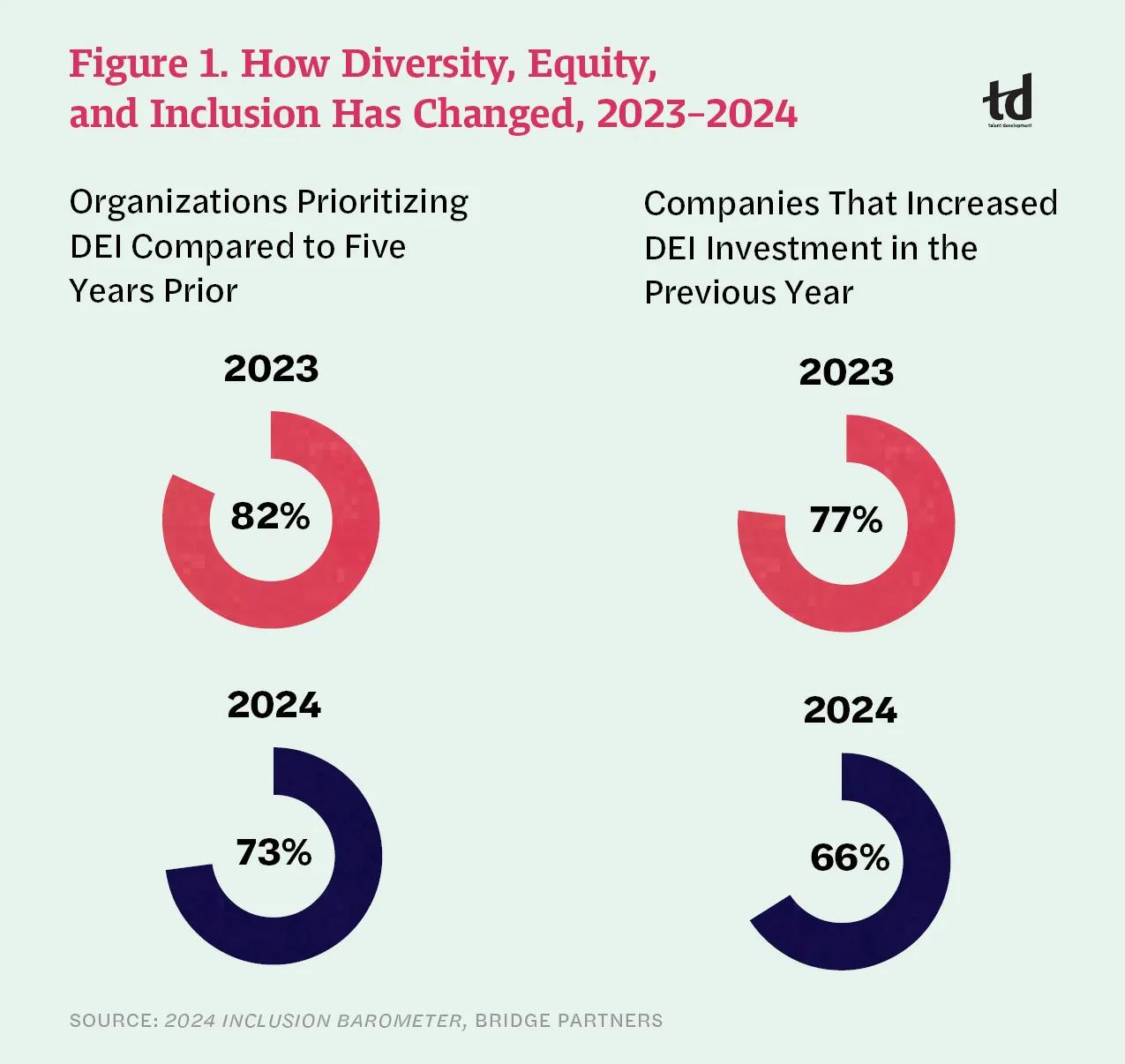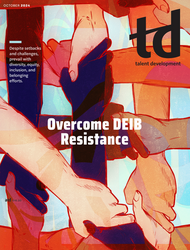TD Magazine Article
Overcome DEIB Resistance
Despite setbacks and challenges, prevail with diversity, equity, inclusion, and belonging efforts.
Tue Oct 01 2024

Amid opposition from state legislatures and special interest groups, the principles of diversity, equity, inclusion, and belonging (DEIB) are essential in the modern corporate world. With more than three decades of experience as a management consultant helping to create inclusive workplaces in various organizations, I've seen the persistence of DEIB initiatives amid significant challenges.
The aftermath of George Floyd's murder in May 2020 emphasized the need for effective DEIB programs, but progress is slow. Creative Investment Research has found that although US corporations pledged a staggering $50 billion toward DEI efforts in the 12 months after Floyd's death, companies have invested only a small fraction of those promised funds—around $250 million. That amounts to less than 1 percent of the total pledged amount. Political disruptions in educational and corporate DEIB programs are increasing, and diversity in DEI leadership roles is notably lacking, with deep cuts and few diverse leaders in top positions.
A global Gallup study reveals widespread workplace dissatisfaction, highlighting the necessity for people-centric policies and strategies. Diverse and engaged teams are crucial for enhancing organizational success.
According to the Bridge Partners 2024 Inclusion Barometer study, there have been some key advancements in DEIB efforts. Among them:
Seventy-five percent of US C-suite HR leaders plan to boost their DEI efforts.
Seventy-two percent aim to expand their DEI programs within two years.
Seventy-three percent acknowledge the growing importance of DEI during the past five years.
Despite historical challenges, DEIB professionals in talent development and corporate learning have shown resilience and innovation. They continue to adapt and advance, fostering a workplace environment that values DEIB. Notably, organizations have used the following methods to successfully counter DEIB opposition and promote more inclusive workplaces.

Listen, learn, and lead
Listen to the needs and concerns of diverse people across the company and seek to understand the viewpoints of DEIB critics as well as those who are negatively affected by inequity. Model empathic leadership in doing what is right and honorable.
For example, in the 1990s, I began my career in DEI training and consulting with an assignment to train Central Intelligence Agency officers. At that time, my approach, like many of my peers, primarily focused on addressing the biases predominantly associated with White males. Over the years, that group has constituted the largest demographic I have worked with, providing ample opportunities to deeply understand their concerns. That exposure has enabled me to refine my methods, shifting from a confrontational style of shame and blame to a more collaborative and empathetic facilitation approach.
I made a concerted effort to foster a training environment that emphasized psychological safety by being forthright about my own biases. By recognizing that all people have biases and framing bias as a universal human condition rather than a targeted or personal fault, I noticed a significant improvement in how participants engaged with the material.
In your organization, encourage participants—and yourself—to engage with information and viewpoints with a sense of curiosity. In other words, when people hear about experiences that are different from theirs, instead of instantly rejecting the experiences, individuals should use those differences to gain a better understanding of the legitimacy of all perspectives. When participants use that tactic, they often become more open and receptive, which facilitates a more productive and transformative learning experience.
Embrace DEIB agility
Be flexible in your approach to DEIB work. Constantly adjust based on the evolving needs and interests of the organization and its diverse constituents.
DEIB initiatives face various challenges, including lack of leadership, employee support, and resources. They also face criticisms, such as inconsistent communication about efforts. Organizations have the autonomy to tailor their responses to such criticisms as they see fit.
Over the years, I've observed DEIB programming shift from civil rights training to affirmative action training to racial sensitivity education to race and gender instruction to diversity training to diversity and inclusion initiatives—and so on. Regardless, inclusion and equity are the ultimate goal, so employers don't have to label programming under a specific language. It's more important for companies to be able to pivot their approach to suit their environment and business needs.
For example, my company, Integrity Development Corp., shifted its focus toward strengthening overall work cultures, leading to the development of CORE initiatives:
Culture. Building people-centered work cultures
Ownership. Encouraging every employee to take responsibility for fostering a positive culture
Respect. Treating respect as a fundamental value, foundational to fairness and equity
Engagement. Actively engaging employees in culture change initiatives
The transition emphasized sustained, value-centered organizational effectiveness over performative measures. Maintaining flexibility and focusing on overarching goals was crucial.
Build trust and confidence by executing projects well
Companies don't give anyone a blank slate to implement every DEIB best practice. Begin by successfully delivering on a project you're leading. Doing so will build others' confidence and trust in you, which often results in an increase in your freedom and support.
The Harvard Business Review article "Why Diversity Programs Fail" indicates that mandatory DEI training often leads to failures in DEI initiatives, citing anecdotal evidence. However, I contend that the issue lies not in the mandatory nature but in the design and execution of the training.
Consider a three-hour DEI training event Integrity Development Corp. conducted for 500 utility company employees, tailored to their practical needs and emphasizing real-world skills.
I started with a few questions: How many of you feel like you have fewer opportunities because you don't have a college degree? How many of you don't feel like there are the same opportunities to move from the union to management as there were 10 years ago? All the hands went up. I told them that my job as the "diversity guy" is to fight for anybody who is left out for any reason other than their talent, skill, and ability.
Despite initial skepticism and political sensitivities, the training received high ratings for effectiveness, with participants expressing gratitude and newfound appreciation postsession. That success not only countered initial reservations but also facilitated ongoing development programs within the organization. Our phased strategic approach to DEI, which involves minimal initial resources and periodic evaluations, proved effective in building trust and driving positive organizational change.
After every session, I give people my card and tell them, "If this is not working, I want you to hold me accountable." People value that. It builds trust.

Inclusion must be inclusive
I often ask participants during inclusion training to indicate what their top workplace diversity issue is. The common responses are gender, race, and unconscious bias. I finally state that "the top diversity issue is the one that affects you personally." I ask the question to make the point that inclusion training and initiatives must be inclusive.
When my four children were young, every Christmas, they would wake me and my wife and up at 12:01 a.m. yelling, "It's Christmas!" After we all went downstairs, they would tear open their presents and put them in a pile. They would next look around at the presents their siblings received to determine which child was their parents' favorite. In the workplace, it can often seem as if employees are just bigger versions of who they were as children—they look around the company to determine who is getting the best gifts or opportunities. Human beings have a fundamental need for a sense of belonging. Leaning too heavily in any one direction could lead to your approach being canceled by voices who feel excluded.
Whether it's racial, ethnic, gender, cultural, neuro-, or any other type of diversity, ensure that initiatives are inclusive of different kinds of employees. For example, a nonprofit agency invited an employee who identifies as a person on the autism spectrum to lead a lunch & learn presentation on neurodiversity during Mental Health Awareness Month. Following the well-attended event, the staff member stated that they had never felt as respected and valued in their life; the DEI effort had lifted their self-esteem.
Establish backlash-reduction strategies
Once you design a DEIB program that is inclusive, proactively communicate that message and develop backlash-mitigation strategies. Backlash may be the resistance presented by narrow-minded people, or—more often—it is the response from people who either feel excluded or believe that the organization's effort is performative versus genuine.
Integrity Development Corp.'s model for decreasing backlash focuses on three key areas.
Dominant-culture diversity issues. At a major automobile manufacturer, for example, we addressed respect and safety before gender or race. The approach minimized resistance by making the training relevant to the majority (White men).
Legitimate diversity issues of traditional groups. For instance, we enhance trust among traditional groups (for example, women, underrepresented minorities, LGBTQ+ staff) by genuinely addressing their concerns through focus groups and actionable plans, reporting back on unresolved issues and encouraging further dialogue.
Individual supervisor-supervisee relationships. Recognizing that employees often leave due to poor management, it's crucial for each manager to foster relationships that cater to individual needs and styles of each employee.
Clarify how DEIB adds value
Continue to stress the DEIB business case. Provide as much organizational data—such as engagement rates, turnover, and program attendance—as possible related to the cost linked to ignoring DEIB or the benefits gained from investing in the practice. Ask leaders to develop commitments and actions as well as communicate business results and stories related to their DEIB work.
For example, we have established an action plan tool for every supervisor and above within several of our clients to reinforce inclusive leadership. The plan has four major components:
Commitment. Identify the commitments and goals you want to accomplish.
Actions. Identify three or four specific actions you will take in support of accomplishing the identified commitments.
Results. Capture the tangible results achieved due to the executed commitments and actions.
Stories. Catalog the stories that are associated with the commitments, actions, and results that take place in relation to the plan.
Such a process enables companies to disseminate best practices throughout the organization and collect ongoing data on the results of fostering an inclusive, people-centered workplace.
Walk the talk and honor everyone you engage
Staff tasked with leading DEIB efforts must deliver empathy, respect, and humility to everyone with whom they interact. Responding to critics with the same negativity targeted at DEIB initiatives strengthens their arguments and misses the opportunity to model the positive impact that DEIB work delivers to company culture.
When encountering criticism during training events, view them as opportunities to embody the values DEIB training aims to instill in participants. Facilitators should use empathic leadership techniques to fully understand the messages and emotions critics convey. Also actively work to bridge the social gaps that exist between all participants. By demonstrating restraint and genuine empathy, facilitators can diffuse the hostility and uncover valuable insights concealed within strong emotional expressions. The experience also can help participants realize that the goal is to ensure that all employees have fair, equitable opportunities.
Ready to lead the change? Explore ATD’s DEI Certificate to drive inclusive progress in your organization.

